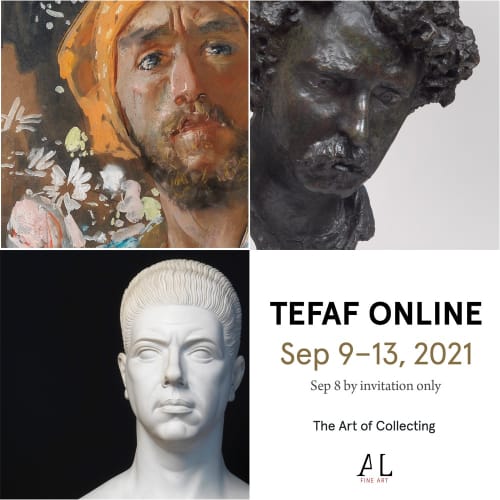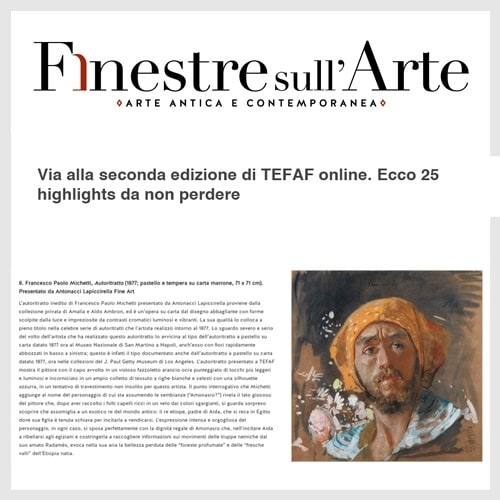TEFAF ON LINE 2021
TEFAF ON LINE 2021
9 - 13 SEPTEMBER 2021
8 SEPTEMBER _ PREVIEW
For this online edition of Tefaf 2021, Antonacci Lapiccirella Fine Art is presenting a coherent, unitary Project which relates three beautiful works by three Italian artists: a fascinating pastel and gouache on paper by Francesco Paolo Michetti, a bronze sculpture by Vincenzo Gemito, and one in marble by Amleto Cataldi. We have chosen to present three works which are different in terms of technique and material but are closely linked thematically. These carefully selected works establish a fruitful dialogue that is rich in historical references and particular assonances. The main theme is that of the PORTRAIT.
Francesco Paolo Michetti
Self-portrait, 1877
The hitherto unpublished Self-portrait of Francesco Paolo Michetti presented here, from the private collection of Amalia and Aldo Ambron, is a work on paper displaying dazzling draughtsmanship with forms sculpted by the light and embellished with bright, vibrant colour contrasts.
The importance is compounded by the fact that Amelia and Aldo Ambron were two collectors driven by a genuine passion for art and for befriending the artists of their day. Their acquisitions were a product of their direct personal involvement, without any mediation. They bought the works they liked from the artists they enjoyed frequenting, including Antonio Mancini, Vincenzo Gemito, Francesco Paolo Michetti and Giacomo Balla.
Its superb quality places it squarely in the celebrated series of Self-portraits which the artist produced in and around 1877. We might point, for instance, the Self-portrait (Jest) in pastel on paper dated 1877, now in the collections of the J. Paul Getty Museum in Los Angeles. For Michetti, the years between 1871 and 1877 coincided with a period of rapid success on the international scene in London and Paris and with an early appearance on the collector's market in America. The question mark that Michetti adds after the name of the character whose appearance he is assuming, Amonasro?, reveals the playful side of the painter who, after gathering his thick, curly hair in a brightly coloured piece of cloth, looks at himself in surprise to discover that he resembles Amonastro the Ethiopian king father of Aida of the homonymous Verdi opera.
His growth as a painter was fuelled by a skilled and eclectic inclination whose goal was the mutual enhancement of light and colour in a new scale of values on the painted surface appearing to fly in the face of the accepted method for constructing perspective. Drawn by the innovations of international naturalism, by an impressionist manner influenced as much by the nervous yet elegant draughtsmanship of Mariano Fortuny.
And not surprisingly, Mariano Fortuny is the protagonist of the second work presented at the fair, a sculpture by Vincenzo Gemito – an artist tied to Michetti by a brotherly friendship.
Vincenzo Gemito
Portrait of Mariano Fortuny, c. 1880
The Portrait of Mariano Fortuny by Vincenzo Gemito is a cast of very lofty technical and formal quality. In this bust, which he designed while still only a very young man, Gemito reveals both his outstanding talent for vibrant naturalism and his skill in capturing a sitter's temperament thanks to his mastery of the realistic rendering of his sitter's facial features.
Mariano Fortuny spent the summer of 1874 in Naples, forging fertile ties with the city's artistic community and basking in the general admiration and enthusiasm of many young artists of the Neapolitan school, such as Antonio Mancini, Francesco Paolo Michetti and Vincenzo Gemito. Impressed by the young man's skill as a sculptor, Fortuny commissioned him to model a terracotta bust of himself, which Gemito carved between October and November 1874.
There are several examples of the portrait bust in Italian public collections. A terracotta model is kept at the Fortuny Museum in Venice, with the pose of the head erect; a second bust cast in bronze in 1875 c. it is now in the Prado Museum; finally, the one with double patina in the collections of the Galleria d’Arte Moderna di Roma Capitale is mentioned.
AMLETO CATALDI
PORTRAIT OF A YOUNG MAN, C. 1920
The third work we have chosen to complete the "Portraits" Project is the marble sculpture by Amleto Cataldi.
The young man offers us a bold, intense stare, his forehead creased in a slight frown just above his perfectly drawn eyebrows, his nose straight, his lips full and equally perfectly delineated. His features are framed in an ideal geometry yet they are handled with a naturalistic touch as though they were living, beating flesh.
Cataldi, who considered portraiture to be "the most energetic and satisfying genre in which a sculptor can express himself", devoted the same degree of attention to this intense young man as he had devoted to portraits of young women. Here the sensitive modelling of the neck and naked shoulders reveals the perfect musculature of a latter-day kouros or of an athlete at rest who, were it not for the fact that he has nothing to indicate his membership of any branch of the armed forces, could well be a preparatory study for the allegorical figure of one of the sculptor's best Monuments, for the Stadio dei Marmi in Rome.
An eminent portrait artist, a sensitive explorer of the faces and the psychology of both the female and male genders, Cataldi embarked on his career in Rome in 1904, showing his work at the annual exhibition held by the Società degli Amatori e Cultori di Belle Arti and setting out down the shining path that was to make of him an extremely skilled and polished sculptor praised by critics even at the international level in the space of only a few years. Thus may well be one of the generically identified busts shown at a one-man exhibition which he held at the Galerie Dévambez in Paris in 1923 where, as we can read in the brief article, he displayed “des nus et des bustes pleins de style et de séduction” duly remarked on by critics.






